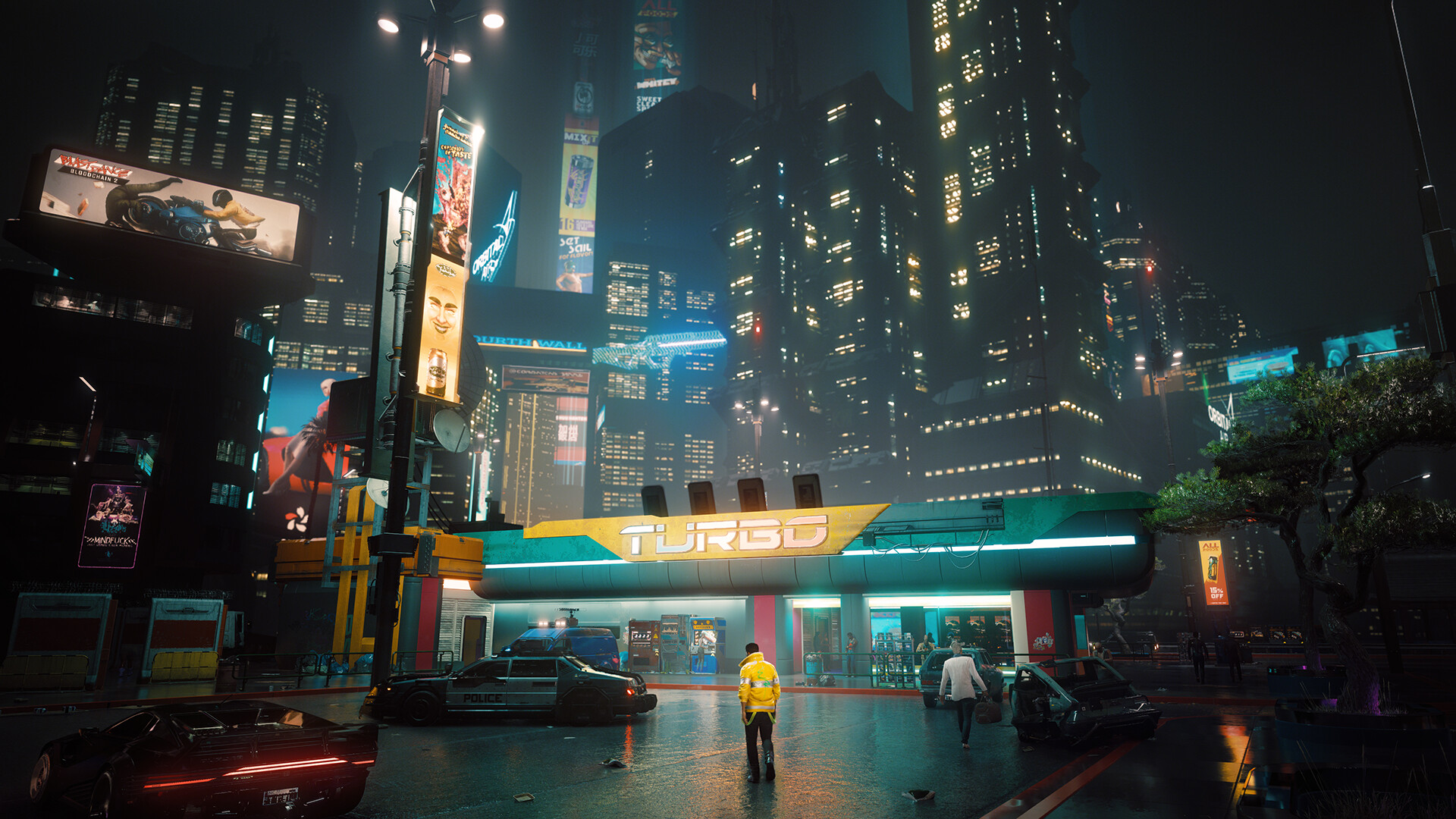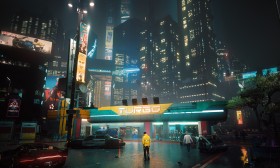Of all the digital ghosts that have haunted the gaming industry over the past decade, few have been as persistent or as polarizing as Cyberpunk 2077. From its mythic, years-long hype cycle to its catastrophic launch and its phoenix-like resurgence, the game’s story is almost as compelling as the one contained within Night City. To review it is to review two distinct entities: the broken promise of 2020 and the polished, ambitious experience of today. This breakdown will focus on the latter, analyzing the core pillars of its Graphics, Story, and Gameplay to understand what truly lies beneath the neon-soaked surface.
Graphics: A Benchmark for Fidelity and Atmosphere – 9.5/10
It is in the realm of visual presentation that Cyberpunk 2077 has always, unequivocally, shone. Even at launch, beneath the crippling bugs on base consoles, there was a stunning next-gen game screaming to get out. Today, especially with the 2.0 update and Phantom Liberty expansion running on modern PC hardware or current-gen consoles, it is nothing short of a technical masterpiece.
Night City is the star. It is not merely a backdrop but a living, breathing, and utterly convincing character. The artistry on display is breathtaking. The game masterfully employs a stark contrast between the opulent, sky-piercing spires of Corpo Plaza, bathed in clean, artificial light and holographic advertisements, and the grimy, rain-slicked alleyways of Kabuki, where steam rises from manhole covers and graffiti tells stories of discontent. The use of ray tracing, or its excellent software-based approximations, creates a city that feels physically believable. Light behaves as light should: it reflects authentically off wet pavement and chrome implants, it casts realistic shadows that deepen the sense of danger in dark corners, and it refracts through glass, adding layers of depth to every scene.
Character models, particularly in key story moments, are incredibly detailed. The facial capture animation is some of the best in the industry, conveying subtle emotions with a flicker of an eye or a tightening of the jaw. This is crucial for a narrative so deeply personal and reliant on player connection to characters like Johnny Silverhand, whose holographic glitches are seamlessly integrated into his model, or Song So Mi, whose pain and desperation are etched into every line of her face.
It’s not a perfect score solely because the ambition can occasionally outpace the reality. Dense crowds can sometimes exhibit robotic behavior, breaking immersion, and very rare texture pop-in can occur when moving at high speeds. However, these are minor quibbles in what is otherwise a landmark achievement in environmental storytelling and visual world-building. Night City is a place you can get lost in, not because of the map, but because you simply want to see what visual marvel lies around the next corner.
Story: A Deeply Personal Descent – 9/10
The narrative of Cyberpunk 2077 is a fascinating beast. On the macro level, it’s a classic cyberpunk tale of corporate hegemony, the loss of humanity, and the futile search for meaning in a world that commodifies everything, including the soul. But where it truly excels is on the micro level: the story of V and Johnny Silverhand.

The main plot, centered on the Relic bio-chip slowly overwriting V’s consciousness with the engram of the infamous rockerboy terrorist, is a brilliant narrative device. It creates a constant, pressing urgency—a literal ticking time bomb in your head. This urgency is both a strength and a weakness. It powerfully fuels the central drama and forges a complex, love-hate relationship with Keanu Reeves’s brilliantly performed Johnny. Their conversations, arguments, and eventual bonding form the emotional core of the entire experience.
However, this relentless urgency can feel at odds with the open-world design. The game constantly tells you that you have weeks, maybe days, to live, yet it incentivizes you to go off and win street races, help cops solve crimes, or become a famed bounty hunter. This ludonarrative dissonance is a common open-world pitfall, and Cyberpunk doesn't entirely avoid it.
Where the story truly soars is in its side content. The major side quests and character arcs are arguably where CD Projekt Red’s writing talent is most evident. The journey with Judy Alvarez to uncover the secrets of Clouds, helping Pan Palmer seek revenge and find a new purpose, or navigating the tragic fate of the Peralez family—these stories are nuanced, morally gray, and profoundly impactful. They explore themes of identity, autonomy, and love with a maturity that the main plot’s more straightforward race for survival sometimes lacks. The Phantom Liberty expansion elevates this further, offering a spy-thriller narrative with branching choices that genuinely alter the fate of its core characters, providing some of the most tense and well-written missions in the entire game.
The story is a 9 because, while the central plot is compelling and character-driven, its pacing issues and the sheer, unmatched quality of its optional content create a slight imbalance.
Gameplay: From Functional to Fantastic (Post-2.0) – 8.5/10
The gameplay of Cyberpunk 2077 has undergone the most radical transformation. At launch, it was a serviceable but often janky shooter with RPG elements that felt superficial. The 2.0 overhaul completely rebuilt this foundation, resulting in a deep, rewarding, and highly customizable action-RPG system.
Combat is now thrillingly versatile. The three core styles—Netrunning (hacking), Blades, and Guns—feel distinct and powerful. A Netrunner can now become a digital phantom, wiping out entire squads of enemies from afar through a cascading series of quickhacks without ever being seen. The Sandevistan operating system turns combat into a blistering, Matrix-style ballet of slo-mo violence where you dart between enemies, slicing them apart before they can even react. Gunplay feels weighty and responsive, with a satisfying variety of smart, power, and tech weapons. The addition of a proper perk and skill tree system allows for incredibly specialized builds that genuinely change how you engage with every encounter.
Movement is enhanced with vehicle combat and a much-improved police system that now creates dynamic chases through the city, though it still doesn’t reach the complexity of dedicated crime sims. The new relic skill tree in Phantom Liberty adds even more verticality and fluidity to exploration.
The RPG mechanics are now deeply embedded. Your choices of cyberware, perks, and clothing (now purely cosmetic, with stats coming from cyberware) significantly impact your capabilities. The world feels more reactive, not through branching dialogue in every conversation, but through how your built character can solve problems—whether by forcing open a door, hacking a terminal, or using sheer strength.
Why an 8.5? Some remnants of its troubled origins remain. Enemy AI, while improved, can still be inconsistent. Driving, though better, still lacks the refined feel of a dedicated racing game, with some vehicles handling like boats on ice. The open-world, while stunning, is still largely a visual feast rather than a systemic one; it’s a world to observe and complete activities in, not one that simulates independent life like a Grand Theft Auto.
Final Verdict
To break down Cyberpunk 2077 is to analyze a game that has achieved a remarkable redemption. It is a title of incredible highs and occasional, lingering imperfections.
- Graphics: 9.5/10 – A visually defining game of its generation, creating one of the most immersive and breathtaking worlds ever realized.
- Story: 9/10 – A powerful, character-driven narrative hampered slightly by pacing but elevated to greatness by its side quests and the masterful integration of Johnny Silverhand.
- Gameplay: 8.5/10 – A robust, deeply customizable, and immensely fun action-RPG system that offers fantastic build variety, even if some elements of its world interaction lack depth.
The final product is a testament to ambition and perseverance. It is not a perfect game, but it is an unforgettable experience. Cyberpunk 2077 finally delivers on its promise: a gripping, heart-wrenching journey through the best and worst of humanity, set against the backdrop of the most dazzling city ever built in a digital world. It is, at long last, truly preem.
















